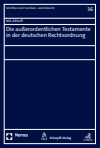Zusammenfassung
Seit der Corona-Pandemie ist in der wissenschaftlichen Auseinandersetzung ein gestiegenes Interesse an den außerordentlichen Testamenten zu beobachten. Die empirische Realität liegt jedoch weiterhin im Dunkeln. Mit seiner Umfrage zur rechtstatsächlichen Bedeutung, an der sich 670 Bürgermeister:innen beteiligt haben, möchte der Autor dies ändern. Die Relevanz der Form hängt maßgeblich von der Erreichbarkeit der Notar:innen ab, wozu die Notarkammern befragt wurden. Von der historischen Entwicklung über die Voraussetzungen bis zur Form der Errichtung untersucht der Autor die §§ 2249-2252 BGB umfassend. Dabei zeigt er die Schwächen der bestehenden Regelung auf. Das Ergebnis ist ein Reformvorschlag, der eine neue, audiovisuelle Testamentsform enthält.
Abstract
Since the Corona pandemic, there has been an increased interest in the extraordinary wills in the scientific debate. The empirical reality, however, remains in the dark. With his survey on the legal significance, in which 670 mayors participated, the author wants to change this. The relevance of the form depends to a large extent on the accessibility of the notaries, for which the chambers of notaries were surveyed. From the historical development over the prerequisites to the form of the making of a will, the author comprehensively analyses §§ 2249-2252 BGB. In doing so, he points out the weaknesses of the existing regulation. The result is a reform proposal that includes a new, audiovisual form of will ("smartphone will").
Schlagworte
accessibility of notaries §§ 2249-2252 BGB audiovisual form of will audiovisuelle Testamentsform außerordentliche Testamente chambers of notaries außerordentliches Testament development extraordinary wills Bürgermeister Entwicklung form of establishment Germany Erben heirs Erbrecht inheritance Erbschaft Erreichbarkeit der Notare inheritance law Form der Errichtung legal history legal significance Notarkammern mayors Realität Rechtsgeschichte reality reform proposal rechtstatsächliche Bedeutung requirements Reformvorschlag survey Umfrage Voraussetzungen- 31–34 1. Teil Einleitung 31–34
- 321–424 3. Teil Einordnung 321–424
- 425–446 4. Teil Reformentwurf 425–446
- 447–474 Literaturverzeichnis 447–474
- 495–506 Abkürzungsverzeichnis 495–506

